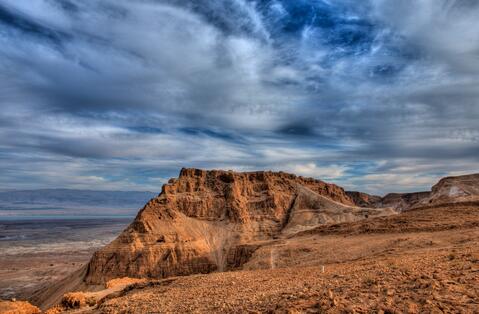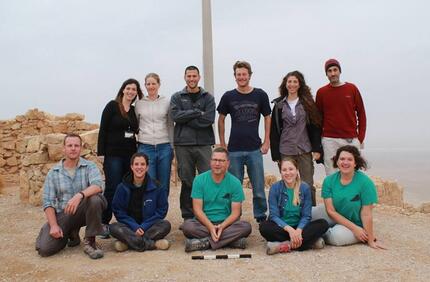Aqua Regis – King Herod the Great’s Usage of Water at Masada
From:Shanghai Archaeology Forum NetWriter:Date:2017-12-10
In February 2017, the archaeological expedition of Tel-Aviv University, headed by Dr. Guy D. Stiebel, returned to the World Heritage site and National Park of Masada. The palatial fortress was built by King Herod the Great (37-4BC) amid the arid Judaean Desert, near the western shores of the Dead Sea. It became an asylum for Jewish rebels during the First Revolt against the Romans and the arena for a famous siege (AD73), whose dramatic ending was narrated in details by the historian Flavius Josephus in his account Bellum Judaicum. It later became the most remote Christian monastery in the Judaean Desert during the Byzantine period (5th-7th centuries AD). The arid climate and the remoteness of the site resulted in excellent preservation of the ruins, both in terms of architecture and especially that of its material culture. The site was first noted in 1806 and was identified with Masada in 1838. Extensive excavations were conducted at the site in the 1960s by the expedition of the HU of Jerusalem headed by Professor Yigael Yadin (1963-65). Further excavation on the site’s plateau at its foot took place in 1989 and between 1995-2001.
Conducted by the Peter and Naomi Neustadter archaeological expedition to Masada and focusing on unexplored areas, four of the six newly excavated areas at Masada were devoted to research themes connected to King Herod the Great — namely, water collection, water installation and gardening. The king had most likely been one of the greatest builders of the Roman East. His reign, in the second half of the 1st century BC, symbolizes the transition between Hellenistic and Roman influences, during which he introduced to Judaea a plethora of new trends, designs and technologies. One of the least explored aspects of his architecture is its water technology and the ways in which water was used. The capacity to build a chain of desert palatial fortresses was first and foremost based on his impressive ability to collect and preserve flash flood water. Water was so abundant that it became a matrix used by the king’s architects to feed his lavish installations and pools, sustain large and private gardens in the middle of the desert and enable the existence of boutique agriculture. The present project offers an intimate observation of this achievement.
Our expedition focuses on several circles and dimensions of activity: water management at the environs of the site and at the site, as well the usage of water on top of the mountain-top palace. An advanced photometric technique that involves the usage of a UAV (drone) was harnessed to provide the first scholarly 3D modelling of the site environ. In addition to gathering the volume of building material used, this documentation provided an accurate record of the water collecting system as well as the trails’ system through which water was brought to the site. As a result, we were able to re-date the “runner trail”, that had been thought until recently to date from the time of the Roman siege. Yet the identification and the meticulous documentation of the newly discovered part and stages of the trail indicated that it was constructed during the reign of King Herod. Several iron shoes of pack animals were found on the trail. The new date led to a new reading of the Greek text of Josephus, clearly suggesting that we have found the “Western Ascend” of the site that was noted by the ancient historian to be constructed by Herod (BJ 7.289). Future probes are planned to extract OSL (Optically Stimulated Luminescence) samples in an attempt to provide more accurate dates as part of the terraces’ dating project, undertaken by Israeli colleagues in the past five years.

As mentioned, Herod’s excessive use of water at the desert site of Masada was no doubt best demonstrated through horticulture. Josephus’s testimony hinted that Masada was a possible arena for royal gardening and agriculture activities:
Τὴν γὰρ κορυφὴν πίονα καὶ πεδίου παντὸς οὖσαν μαλακωτέραν ἀνῆκεν εἰς γεωργίαν ὁ βασιλεύς, ἵν᾽ εἴ ποτε τῆς ἔξωθεν τροφῆς ἀπορία γένοιτο, μηδὲ ταύτῃ κάμοιεν οἱ τὴν αὐτῶν σωτηρίαν τῷ φρουρίῳ πεπιστευκότες.
(Ἰώσηπος, Ἰωσήπου ἱστορία Ἰουδαϊκοῦ πολέμου πρὸς Ῥωμαίους βιβλία Ζ, 288)
For the king reserved the top of the hill, whose soil was rich and softer than any valley, for agriculture, so that if ever there arrived some difficulty in procuring provisions from the outside, those who had entrusted their safety to the fortress would not be made destitute by this hardship (Josephus, The Jewish War, 7.288)
This set before us a great challenge to develop scientific tools and methods that allow for the impartial identification of such activity and installations. Thus the prospect of Herodian cultivation of a royal garden and plantations at the site was examined in cooperation with a team from Dr. Dafna Langgut’s archaeobotanical laboratory at TAU. Advanced pollen sampling and analysis of soil samples has been employed as well as the examination of the microcharcoal remains.
Using the technique developed by Langgut et al. (2013), in excavating the Upper Terrace of the Northern Palace our team successfully extracted a few pollen grains of olive (Olea europaea) and grape (Vitis vinifera) from the plaster of a structure at a depth of 1.2m below current surface. Though further excavation and collection of botanical remains is required in order to reach a more comprehensive picture, these preliminary results appear to point to the presence of a viridarium in the terrace, as was proposed by Stiebel.

One of Israel’s leading poets, Yehuda Amichai, dedicated a book of poems to the Judaean Desert – Open Eyed Land. There one may read:
No grower of bees
Would put his
Beehives here.
But people
Sometimes make honey from desolation
Sweeter than anything
In a world where the threats of global warming and water shortage are becoming ever more evident, an understanding of old methods of water management in arid zones appears to bear much relevance to our societies. Moreover, the discovery of well-adjusted species to arid climates may offer new insights about ancient agriculture and economy and possibly contribute to the potential revival of now extinct plants.

